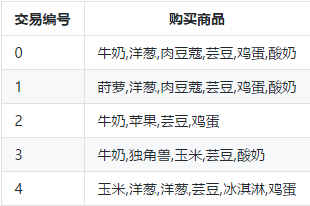一、Apriori算法原理
参考:Python --深入浅出Apriori关联分析算法(一)www.cnblogs.com
二、在Python中使用Apriori算法
查看Apriori算法的帮助文档:
from mlxtend.frequent_patterns import apriori
help(apriori)
Help on function apriori in module mlxtend.frequent_patterns.apriori:
apriori(df, min_support=0.5, use_colnames=False, max_len=None, verbose=0, low_memory=False)
Get frequent itemsets from a one-hot DataFrame
Parameters
-----------
df : pandas DataFrame
pandas DataFrame the encoded format. Also supports
DataFrames with sparse data;
Please note that the old pandas SparseDataFrame format
is no longer supported in mlxtend >= 0.17.2.
The allowed values are either 0/1 or True/False.
For example,
#apriori算法对输入数据类型有特殊要求!
#需要是数据框格式,并且数据要进行one-hot编码转换,转换后商品名称为列名,值为True或False。
#每一行记录代表一个顾客一次购物记录。
#第0条记录为[Apple,Beer,Chicken,Rice],第1条记录为[Apple,Beer,Rice],以此类推。
```
Apple Bananas Beer Chicken Milk Rice
0 True False True True False True
1 True False True False False True
2 True False True False False False
3 True True False False False False
4 False False True True True True
5 False False True False True True
6 False False True False True False
7 True True False False False False
```
min_support : float (default: 0.5)#最小支持度
A float between 0 and 1 for minumum support of the itemsets returned.
The support is computed as the fraction
`transactions_where_item(s)_occur / total_transactions`.
use_colnames : bool (default: False)
#设置为True,则返回的关联规则、频繁项集会使用商品名称,而不是商品所在列的索引值
If `True`, uses the DataFrames' column names in the returned DataFrame
instead of column indices.
max_len : int (default: None)
Maximum length of the itemsets generated. If `None` (default) all
possible itemsets lengths (under the apriori condition) are evaluated.
verbose : int (default: 0)
Shows the number of iterations if >= 1 and `low_memory` is `True`. If
>=1 and `low_memory` is `False`, shows the number of combinations.
low_memory : bool (default: False)
If `True`, uses an iterator to search for combinations above
`min_support`.
Note that while `low_memory=True` should only be used for large dataset
if memory resources are limited, because this implementation is approx.
3-6x slower than the default.
Returns
-----------
pandas DataFrame with columns ['support', 'itemsets'] of all itemsets
that are >= `min_support` and < than `max_len`
(if `max_len` is not None).
Each itemset in the 'itemsets' column is of type `frozenset`,
which is a Python built-in type that behaves similarly to
sets except that it is immutable.
练习数据集:
提取码: 6mbg
部分数据截图:
导入数据:
import pandas as pd
path = 'C:\\Users\\Cara\\Desktop\\store_data.csv'
records = pd.read_csv(path,header=None,encoding='utf-8')
print(records)
结果如下:
使用TransactionEncoder对交易数据进行one-hot编码:
先查看TransactionEncoder的帮助文档:
from mlxtend.preprocessing import TransactionEncoder
... help(TransactionEncoder)
...
Help on class TransactionEncoder in module mlxtend.preprocessing.transactionencoder:
class TransactionEncoder(sklearn.base.BaseEstimator, sklearn.base.TransformerMixin)
| Encoder class for transaction data in Python lists
|
| Parameters
| ------------<








 最低0.47元/天 解锁文章
最低0.47元/天 解锁文章















 1万+
1万+











 被折叠的 条评论
为什么被折叠?
被折叠的 条评论
为什么被折叠?








